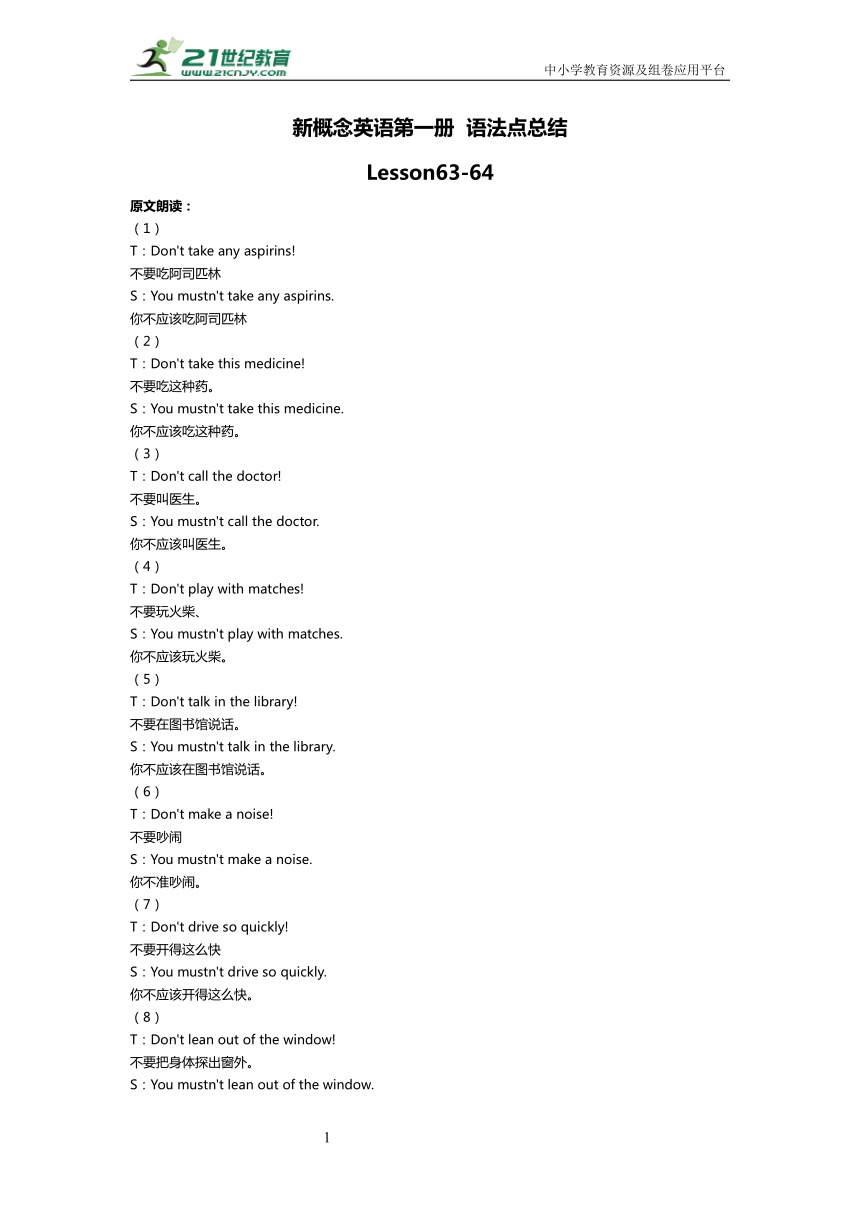
中小学教育资源及组卷应用平台 新概念英语第一册 语法点总结 Lesson63-64 原文朗读: (1) T:Don't take any aspirins! 不要吃阿司匹林 S:You mustn't take any aspirins. 你不应该吃阿司匹林 (2) T:Don't take this medicine! 不要吃这种药。 S:You mustn't take this medicine. 你不应该吃这种药。 (3) T:Don't call the doctor! 不要叫医生。 S:You mustn't call the doctor. 你不应该叫医生。 (4) T:Don't play with matches! 不要玩火柴、 S:You mustn't play with matches. 你不应该玩火柴。 (5) T:Don't talk in the library! 不要在图书馆说话。 S:You mustn't talk in the library. 你不应该在图书馆说话。 (6) T:Don't make a noise! 不要吵闹 S:You mustn't make a noise. 你不准吵闹。 (7) T:Don't drive so quickly! 不要开得这么快 S:You mustn't drive so quickly. 你不应该开得这么快。 (8) T:Don't lean out of the window! 不要把身体探出窗外。 S:You mustn't lean out of the window. 你不应该把身体探出窗外。 (9) T:Don't break that vase! 不要打碎花瓶。 S:You mustn't break that vase. 你不应该打碎花瓶。 情态动词 mustn't 和 don't 的区别: 首先,情态动词基本知识: 1. 主要的情态动词有: must, will, would, should, can, could, may, might, shall, should 另外属于情态动词还有: ought to, have to, used to, need, dare, had better, would rather, might as well 2. 情态动词+动词原形共同构成谓语,用来表现各式各样的语气或态度,不能单独使用。 3. 情态动词must主要有两种用法: 同样一个情态动词,可能有两种不同的用法。以下面这两个句子(must) 为例: You must do your homework more carefully. 你做作业必须更仔细。(在这里的情态动词可表达意愿、义务、责任、能力、许可等等。) b. John must be very careless. 约翰一定是很粗心。(在这路的情态动词则是用来「表示猜测」) 若要谈论过去的情况,必须用“must+have+过去分词”。 如:You must have mistaken my intention. 你一定是误会了我的意图。 She must have been very young when she got married. 她结婚时一定很年轻。 He must have come this way, here are his footprints. 他一定是走这条路来的,这里还有他的脚印呢。 5. 表示“偏偏”有时must可表示某事发生得不早不迟,就在某个当紧的时候,多指某些不受欢迎的事情的发生。 The car must break down just we were starting our holidays. 我们刚刚开始休假,汽车偏偏坏了。 Must you worry her with questions, just when she is busy cooking dinner 她正忙着做饭你干吗偏偏问她问题 Just when I was busy, the neighbor must come and chatter. 正当我忙碌的时候,邻居偏偏过来聊天。 有时还可指主观上的偏执或固执,常可译为“偏”、“偏要”。 After I gave her my advice,she must go and do the opposite. 在我给她出主意之后她偏要反着干。 Must you make so much noise 你就非得弄出这么大的声音吗 6. must 与 have to 的区别: a. 两者都表示“必须” 但must 侧重于说话者的主观看法,认为有必要或有义务去做某事; have to 则重于客观需要,含有“不得不”“被迫”之意。 Everyone must keep the law. 人人都要守法。 The last train has gone. We'll have to walk home. 最后一班车已经开了,我们得走回家了。 从时态方面看,must 只有现在时一种形式(在宾语从句中可以表示过去),而 have to 则有多种时态形式。如: You will have to show your papers at the gate.在大门口你得出示证件。 We have had to post ... ...
~~ 您好,已阅读到文档的结尾了 ~~